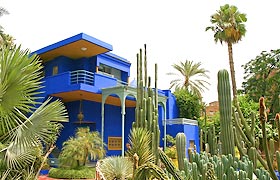Visit the Berber Museum at Majorelle Garden


Located in the heart of Marrakech, the Majorelle Garden is an oasis in a busy city, and one of its most popular attractions. In addition to enjoying the beauty and tranquility of nature, visitors can learn some fascinating facts about the Berbers of Morocco when visiting the Majorelle Garden at the museum which displays the personal collection of Yves Saint-Laurent and Pierre Bergé, who until recently were the patrons of the garden created by French artist Jaques Majorelle (1886-1962).
Pierre Bergé was long fascinated by the rich culture and art of the Berber people and identified with their need to have their culture, including their language, acknowledged and preserved. The new Moroccan Constitution which was adopted in July 2011, officially recognized and formalized the Amazigh language of the Berber people, reconfirming the thoughts of His Majesty King Mohammed VI in a speech in Mar 2011 where he state that the plurality of the Moroccan identity is united and enriched by its diversity, which includes the Amazigh, the common heritage of all Moroccans.
Imazighen, or Berbers, form the foundation of indigenous North African people, with their origin believed to stretch back more than 9,000 years. They are unified by their language and culture which they have maintained over the centuries, despite some tumultuous times. The culture has a sense of community, a strong bond to the earth and a deep relationship with the sacred. The recognition afforded it by the new Constitution of Morocco will help ensure the Berber culture is preserved into the future.
Jacques Majorelle beautifully captured the emotions, colors and spirit of the Berber culture in his artworks, many of which are displayed at the Berber Museum. Other items on display include traditional handcrafted items in leather, pottery, basketry and woodworking. Decorative geometric patterns are very evident in household and decorative items, as well as those used in rituals. Ornaments and jewelry on display include intricately crafted headdresses, brooches, necklaces and earrings. Materials and techniques used in creating jewelry are varied, with filigree, engraving, carving, enamel-work and molding producing unique items. Depending on the region and local availability, jewelry incorporates silver, coral, amber and amazonite.
A section of the museum is devoted to displaying traditional clothing worn at various festive occasions such as weddings and moussems. While certain aspects are uniform, and therefore readily identified with the Berber culture, there is room for great diversity, with jewelry and accessories reflecting personal tastes. Certainly, a visit to the Berber Museum at the Majorelle Garden will provide much insight into this fascinating and ancient culture.
morocco culture,moroccan food,morocco food,moroccan cuisine,morocco beaches,moroccan meal,beaches in morocco,moroccan culture,hercules cave,hercules cave morocco
